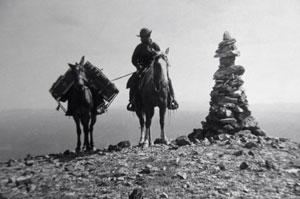William H. Jackson was a photographer on the now famous Hayden Geological Survey of the Yellowstone region in 1871, and his images are often cited as an important factor in the campaign to have the area established as a national park.
In 1938, at the age of 94, W. H. Jackson returned to the park for a visit, and an old report about his trip offers some fascinating insights into the Hayden Survey and how times have changed in the world of photography.

W. H. Jackson packing a mule during the 1871 survey. NPS image.
In an earlier era in the NPS, parks apparently produced a monthly superintendent's report which summarized both basic statistics and noteworthy events. One such report from Yellowstone for August 1937 includes a news release about a return visit to the park by photographer William H. Jackson.
Modern-day photographers rarely give much thought to the ability to snap hundreds of digital photos in a day's time, using camera equipment that can be easily slung about our necks or even carried in one hand. It was a much different story in 1871, as described by Jackson as he reminisces about his experiences nearly seven decades after he took those original images.
Here's a transcript of that report from 1937:
As agile of mind and body as a man half his age, W. H. Jackson, 94, of New York city, official photographer with the Hayden expedition into Yellowstone national park in 1871, revisited recently for his twenty-fifth time his favorite vacationland.
The vigorous old man, whose photographs were a great factor in making Yellowstone a national park in 1872, saw again all those points which he and his party found in the wilderness of 66 years ago. His acute memory picked out hundreds of minute changes in the area and likewise great numbers of similarities.

Jackson's 1871 photo of Tower Falls. NPS image.
After leaving Mammoth Hot Springs, where the Hayden expedition started its exploratory tour, he was whisked by automobile over approximately the route which he followed in 1871. At Tower Falls he noted a large boulder perilously perched on the brink of the 139-foot fall. He remarked that members of his expedition had wondered whether the boulder would still be at its position the following year or even the following month.
Motorists now are accustomed to seeing black bears sitting on their haunches along the roadside begging for food, but Jackson reflected that not a single bear was seen by any one of the party on the 1871 trip. Seeing an elk and a moose prompted him to reflect that there were elk and mountain sheep at that time.
As he came to the Grand Canyon of the Yellowstone he pointed out the spot from which his friend Thomas Moran had painted the first canyon picture. Fording the Yellowstone between the upper and lower falls, he declared, was one of the most difficult tasks encountered.

W. H. Jackson with camera equipment on Mt. Washburn in 1871. NPS image.
As he climbed around points of interest with his high-speed, modern miniature camera in hand, he spoke of the difficulties of picture taking with 1871 equipment. Three pack horses carried his equipment and two assistants helped him set it up then. With the three men functioning against time in an effort to set a speed record they timed themselves in 30 minutes for one picture. It was not at all uncommon for a man to have to stand still for 10 minutes to have his picture taken, Jackson said. Two to three hours was much more common for a scenic that set the 30-minute record.
With all these difficulties to be overcome there was hardly a scenic spot in all the more than two million acres of the park that Jackson missed. One year after his photographs were exhibited in Washington, D. C, Yellowstone was made a national park.
One major ambition was not realized by Jackson on his 1937 visit. A series of afternoon storms made it impossible for him to see the park from the air. Each afternoon he inquired about prospects for flying over the area he had first seen 66 years ago but his hopes were frustrated.

W.H. Jackson in a self portrait in 1871. NPS image.
Twenty-eight years old when he joined Hayden, Jackson had been photographing for the Union Pacific railroad since 1866. He returned to the park in 1873 and 1878 with further expeditions after which he established a photographic business in New York.
Many of his pictures are now on file in the Ford museum at Dearborn, Michigan and more are in the Department of the Interior files. He has written a book on his adventures in the west, "The Pioneer Photographer," published in 1929 by the World Book Company.
William H. Jackson lived to the age of 99, and died in 1942 in New York. Mount Jackson, on the western side Yellowstone National Park, is named in his honor.


 Support Essential Coverage of Essential Places
Support Essential Coverage of Essential Places







Comments
Thank you for posting this! As a fan of Yellowstone's history, this was well worth reading.